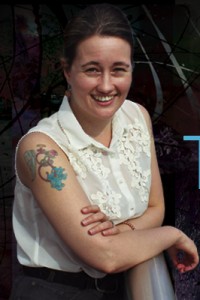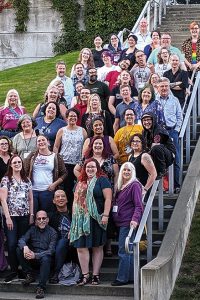Annalee Newitz: Terraforming

Annalee Newitz was born May 6, 1969 in Santa Monica CA, and grew up in Irvine. They attended UC Berkeley, where they completed a PhD in English and American Studies in 1998; their dissertation was published as Pretend We’re Dead: Capitalist Monsters in American Pop Culture (2006). They began freelance writing in the mid-’90s, and have written full-time since 1999, mostly as a journalist focusing on technology and science. They wrote for the San Francisco Bay Guardian for many years, serving as culture editor from 2000-2004, and were awarded a Knight Science Journalism Fellowship for 2002-2003, serving as a research fellow at MIT. They were a policy analyst for the Electronic Frontier Foundation from 2004-2005.
Newitz founded SF website io9 in 2008, and served as editor-in-chief for its entire tenure. io9 was combined with Gizmodo in 2015, and Newitz left shortly after to join Ars Technica, where they were Tech Culture Editor, then became a contributor to the New York Times op-ed section. Currently, they are a columnist for New Scientist magazine. With Charlie Jane Anders, they co-host a podcast, Our Opinions Are Correct, launched in 2018, which won Hugo Awards in 2019, 2020, and 2022.
Their non-fiction book Scatter, Adapt, and Remember: How Humans Will Survive a Mass Extinction appeared in 2013 and was nominated for the LA Times Book Prize in science, and Four Lost Cities: A Secret History of the Urban Age came out in 2021.
Newitz has published a handful of short stories, beginning with “The Gravity Fetishist” (2010). Recent stories include Theodore Sturgeon Memorial Award winner “When Robot and Crow Saved East St. Louis” (2018), “#SelfCare” (2021), and “A Hole in the Light” (2022).
Debut SF novel Autonomous was published in 2017, and was a Nebula Award finalist and winner of a Lambda Award. The Future of Another Timeline appeared in (2019) and was nominated for a Dragon Award and won the Sidewise Award. Their latest book, The Terraformers, will be published at the end of January.
“My latest book is called The Terraformers and it is a multigenerational epic about terraforming a planet. As it says on the tin, it is about some terraformers, the people doing the real work planetside, and it takes place over many thousands of millennia. It starts about 60,000 years in our future and ends 65,000 years in our future. I spent a lot of time working on the timeline leading up to the events of the novel. I have all these files on my computer that are full of things like, ‘Okay, but if this happened at this date, then what would happen at this date?!’
“It’s really about the relationship between the interstellar real estate company that is terraforming the planet and the workers who are doing the terraforming. Each generation of terraformers has a slightly different kind of body. As the planet gets closer and closer to being Earthlike, there’s more oxygen in the atmosphere and the temperature changes, so the company needs to manufacture different kinds of workers for different phases in development. It’s also a classic posthuman future where pretty much every life-form on the planet is genetically engineered and manufactured. You have people who are Homo sapiens, and you have a lot of knockoff Homo sapiens-types, which are called Homo alteris – they are cheaper, or modified in some way. Most people are some kind of Homo alteris in this world – they’ve built themselves to have armored skin, or wings, or beautifully sculpted foreheads, or whatever they like. There are also a lot of nonhuman animals who have human-equivalent intelligence: there’s a major character who is a moose, several robots, and a cyborg cow. As the book goes on, we get more and more characters who are not Homo sapiens and in the final section of the book, the last generation, the main character is a sentient flying train. I got to tell a story from the perspective of public transit, which made me really happy, because I spend a lot of time on public transit and I think a lot about it.
“In a typical multigenerational novel, you follow the children of the main characters, and then their grandchildren – I definitely had that model in mind, but I wanted to get away from nuclear families. I wanted the book to be about a true inheritance which is not biological. The character in the first section is named Destry, and she doesn’t have children – nobody really has children, because they manufacture new life forms – but she does become the mentor to a person who is a major character in the second section. The lineage isn’t a lineage of parentage – it’s a lineage of intellectual mentorship, and work mentorship. In the final section, the train is the brainchild – and, in some sense, the literal child – of two characters from the second section. You’ll have to read the book to figure out how that works.
“The book is about how culture develops on this planet, and the further you get into the story, the more you’ll understand about how their culture started back on Earth. Our era of Earth history is barely remembered by these people – it’s 60,000 years ago, so it’s like us looking back on when humans were first doing art in caves: ‘We know some things about them, and we guess we have a lot in common with them, because they were obsessed with pictures of big dicks, and so are we….’ I mean, look, I’m not being obscene here; there are a lot of dicks in cave paintings. The terraformers view us as being from this mythological distant past, and their culture is based on events that have not yet happened in our world today.
“One of the things that’s nice about writing about a very distant future is that it’s almost like a secondary world because it’s so far away, and so much could have happened. In 60,000 years, humans might be anywhere. We might have speciated – and, in fact, we have, in my book and in lots of other posthuman science fiction, like by Iain M. Banks or in N.K. Jemisin’s Broken Earth Trilogy. You get these far-future civilizations that look like they’re not even related to humanity at all. Maybe they’re not! Maybe they just seem like they are. Star Wars is the same way: it’s a distant past in another galaxy, but it’s also a secondary world.
“When I set out to do this, I had a couple of very definite ideas in mind. As I said earlier, I wanted it to be one of those multigenerational epics that I have loved reading. A lot of those stories – because they were by authors like Willa Cather from the United States – were about white settlers moving west in the country. I was thinking about how much the West changed in just a few generations, and how violent and horrifying that process was for the Indigenous people who had been living here for thousands of years.
“So my perspective on futurism is shaped by my experiences as someone who has grown up in the Americas, where there is a long tradition of Indigenous civilizations going back much further than European colonizers. In the far future of The Terraformers, a lot of the Indigenous traditions from the West wound up enduring longer than the Christian traditions that the Europeans brought over. Of course, they’re not the same as contemporary Indigenous traditions. They’re part of a murky historical backstory where many human cultures of the Anthropocene have become a big blob of undifferentiated ancient ideas, and those eventually led to a set of beliefs that we wouldn’t recognize today.
“To explore this new belief system, I imagined a group called the Environmental Rescue Team. They’re engineers who do environmental work and land management and help with projects like terraforming on different worlds. But they are also almost a spiritual order. Elements of religion and science have been smushed together, so that’s the other strand in this book’s worldbuilding: imagining the future of spiritual and cultural traditions, plus the future of engineering and science, and putting them all together in the philosophy of this very influential group. The Environmental Rescue Team shapes the lives of the characters in the book – they all have different relationships with it. Some of them are part of the organization, and they’ve been enlisted to help with this terraforming project in a sketchy way. They normally would not be involved with a private development company, but they’ve been pulled in, and that’s part of what the book is about. How did this interstellar engineering-spiritual order get sucked into a private development project?
“This is a book about the struggle for power over labor, but also power over the land. This company lays claim to a planet as real estate, and then they bring all these workers to the planet and let them live there while they spend thousands of years developing the place. The workers live on the planet, but it’s not really theirs – they don’t even belong to themselves, because all these people have been manufactured by the company. They are literally property, and they know that, and they talk about what that means: to be property, and to be developing property. The question of how they can push back and gain some sovereignty becomes a big issue. One of the central dramas of the book revolves around a group of people who have run away and built a renegade city hidden under a volcano. They have a very different approach to managing the land, laying claim to the land, which leads to a whole wonky debate over how land ownership works in this book.
Cover and interview art and design by Francesca Myman
This report and more like it in the January 2023 issue of Locus.
 While you are here, please take a moment to support Locus with a one-time or recurring donation. We rely on reader donations to keep the magazine and site going, and would like to keep the site paywall free, but WE NEED YOUR FINANCIAL SUPPORT to continue quality coverage of the science fiction and fantasy field.
While you are here, please take a moment to support Locus with a one-time or recurring donation. We rely on reader donations to keep the magazine and site going, and would like to keep the site paywall free, but WE NEED YOUR FINANCIAL SUPPORT to continue quality coverage of the science fiction and fantasy field.
©Locus Magazine. Copyrighted material may not be republished without permission of LSFF.







